Articles

Article
Can Candle Dye Be Used In Skin Care Products?
No, unfortunately our dyes are oil based and not meant to be used in skin care products. There are other dye products on the market that are safe to use in coloring skin care products.

Article
How Can I Get A Strong Scent Throw?
How to Enhance the Smell of a Candle: Key Factors for Better Scent Throw
Many factors can affect the scent throw in finished candles. Here are some variables that can impact scent throw:
Type of Wax Used
Impact on Scent Throw: Fragrance oils can perform very differently based on the type of wax used. Some fragrance oils, no matter how much trial and error, just will not blend with certain types of waxes. Soy waxes are known to be more ‘picky’ about the fragrance oils that work well in them. Generally, paraffin waxes still provide better scent throw than soy waxes.
Fragrance Oil Brand
Quality and Ingredients: Some fragrance oils are manufactured stronger than others using more natural ingredients and lower amounts of solvent, which tones down the fragrance strength. Choosing high-quality fragrance oils is crucial for making strong scented candles.
Fragrance Notes
Strength and Intensity: Not all fragrance oils are meant to have overpowering strength. Some are designed to provide a soft, subtle scent. Understanding the fragrance notes can help in selecting the right oils for your desired scent throw.
Amount of Fragrance Oil Used
Optimal Usage: Using too little fragrance oil will lead to a candle with very little scent throw. We recommend using our fragrance oils at 1 oz. per pound for optimal scent throw. Some fragrance oils on the market are manufactured at lower strength levels and may require up to 1.5 to 2 oz. of fragrance per pound. However, using too much fragrance oil can impair burning characteristics and does not necessarily enhance the smell of a candle.
Temperature at Which the Fragrance Was Added
Temperature Control: Adding fragrance oil at too high of a temperature may cause it to dissipate or burn off in the melted wax. Adding fragrance oil at too low of a temperature may prevent it from dispersing and binding uniformly in the melted wax. We recommend adding fragrance oil around 180° - 185°, which we have found to be a good temperature that is not too hot or too cool for making strong scented candles.
Additives Used
Enhancing Fragrance Retention: The use of additives, such as vybar, can enable wax to retain higher fragrance loads. However, many waxes on the market today come pre-blended and already contain additives. They can retain fragrance loads of 8% - 12%, and additional additives are generally not needed. For certain waxes, such as straight paraffin wax, additives can aid the wax in holding higher amounts of fragrance oil.
Proper Wick Selection/Size
Achieving the Right Burn Pool: Having the right wick size to achieve the proper burn pool can help with the scent throw. Too small of a wick will create a small burn pool, leading to poor scent throw. Too large of a wick may burn too hot and burn off the fragrance, also leading to poor scent throw. Finding a wick that has a steady flame and creates a full burn pool of approximately 1/4" to 1/2" deep can help with achieving good scent throw.
Time Allowed for Curing
Curing Recommendations: Allowing sufficient time for curing is essential for enhancing the scent throw. Here are our recommendations:
Paraffin Wax: Allow curing for at least 24 - 48 hours.
Soy Wax: Allow curing for at least 1 - 2 weeks.
Additional Tips for Making Strong Scented Candles
Experimentation:
Test Small Batches: Always test small batches when experimenting with new fragrance oils or waxes.
Record Results: Keep detailed records of your processes and results to replicate successful batches.
Understanding Hot Throw in Candle Making
Hot Throw: Refers to the scent throw when the candle is burning. Ensuring good hot throw involves selecting the right wax, wick, and fragrance oil, as well as allowing proper curing time.
Achieving the Best Scent Throw
Understanding and controlling the various factors that affect scent throw can significantly enhance the smell of a candle. By carefully selecting your wax, fragrance oil, and wick, and by following the recommended steps for adding fragrance and curing, you can make strong scented candles that fill a room with delightful aromas. Keep experimenting and refining your techniques to achieve the best results.
You May Also Like
Top 10 Scents for Women

Article
What Are Notes In Fragrance Oils?
A fragrance is divided into 3 distinct parts: top note, middle note, and base note. Each of these usually has an assortment of ingredients.
Top Note – This is the initial immediate smell you notice when you sniff a fragrance oil. This is known as the initial fragrance ‘burst.’
Middle Note – This is considered to be the heart of the fragrance and becomes more prevalent once the top note dissipates.
Bottom Note – The base notes are long lasting and provide depth to the fragrance. Also referred to as the 'dry down.'
You May Also Like
Top 10 Scents for Women
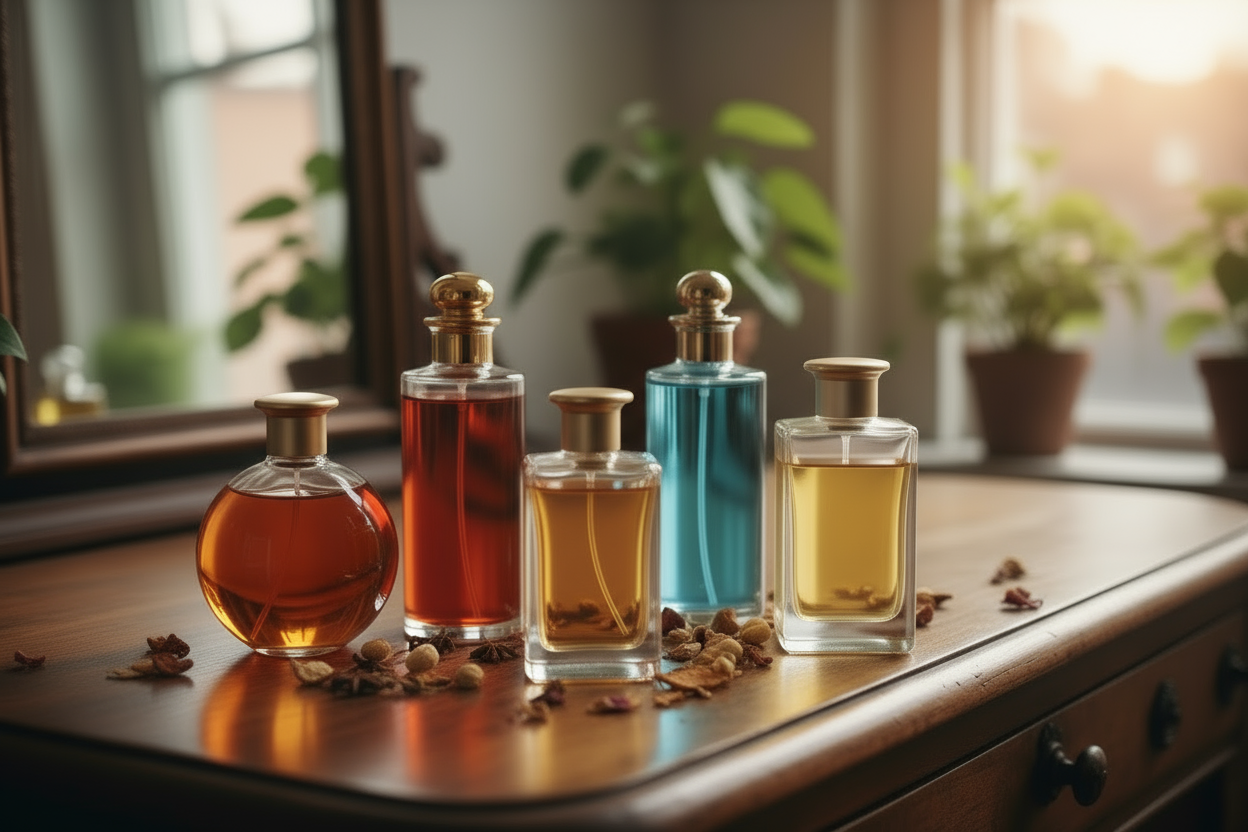
Article
What Is 'Manufacturer's Grade' Fragrance Oil?
Some fragrance oil suppliers promote their fragrance oils as being ‘Manufacturer’s Grade.’ Choosing fragrance oil that is labeled as ‘Manufacturer’s Grade’ sounds like an easy decision. But what does this actually mean? The honest answer is that this is nothing more than marketing hype. There is no formally accepted grading scale for synthetic fragrance oils. We could create a label for our fragrance oils such as ‘AAA Rated for Strength’ or ‘Extreme Scent Throw Grade,’ but this is something we feel is devious and choose not to do. Quite simply, we pay a premium to have our fragrance oils manufactured strong and highly concentrated. We are confident in the performance of our fragrance oils and do not feel the need to use marketing hype in promoting them.
You May Also Like
Top 10 Scents for Women

Article
Do Fragrance Oils Smell Difference in Wax vs. In The Bottle?
Yes, fragrance oils can smell very different in a finished candle than they do out of the bottle. Fragrance oils are more concentrated when they are in the bottle and become less concentrated as they are diluted in wax, thus altering the original concentrated smell. Some fragrance oils may lose their strength altogether when placed in wax and become diluted. However, our quality concentrated fragrance oils retain their strength in finished candles due to the low amount of solvent used.
You May Also Like
Top 10 Scents for Women
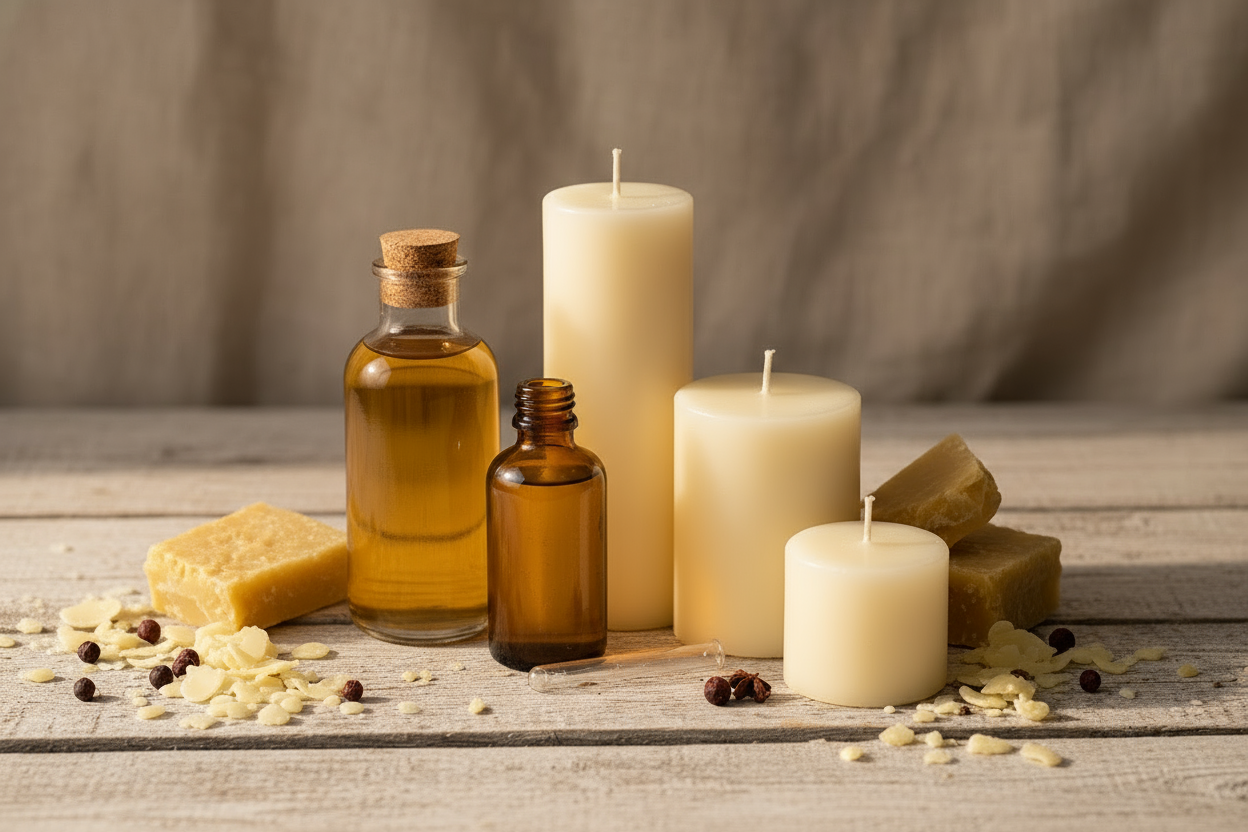
Article
What Does The Maximum Fragrance Load or % Mean?
Understanding Fragrance Load in Candle Making
The term fragrance load refers to the maximum percentage of fragrance oil that a particular wax can hold. This is an essential factor in candle making, as it determines how much fragrance oil you should use to achieve the desired scent strength without compromising the quality of your candle.
How Much Fragrance Oil Per Candle?
When determining how much fragrance oil per candle to use, it's crucial to follow the manufacturer’s guidelines for the wax you’re working with. For instance, if you're using a wax with a maximum fragrance concentration of 10%, and you're making a 16 oz. candle, you can add up to 1.6 oz. of fragrance oil (16 oz. * 10% = 1.6 oz.). Exceeding the recommended fragrance load can result in issues such as poor burning characteristics or the appearance of sweating, where the excess fragrance seeps from the candle.
What is Fragrance Load?
Fragrance load is the maximum amount of fragrance that a wax can retain without affecting its performance. For example, paraffin wax often has a lower scent capacity, typically around 3%, unless additives like Vybar are used to increase its capacity. On the other hand, many pre-blended waxes or those with additives can hold higher fragrance loads, sometimes up to 12%, allowing for a stronger scent throw in your finished candles.
Recommended Fragrance Load for Testing
For beginners, a good starting point is to use 1 oz. of fragrance oil per 1 lb. of wax. This results in a fragrance load of approximately 6.3%, a safe and effective amount for testing the performance of your candle. Always remember to calculate the fragrance load by weight, not by volume, to ensure accuracy.
By understanding and properly calculating the fragrance load, you can create candles that not only smell wonderful but also burn correctly and look great and safe.
You May Also Like
Top 10 Scents for Women
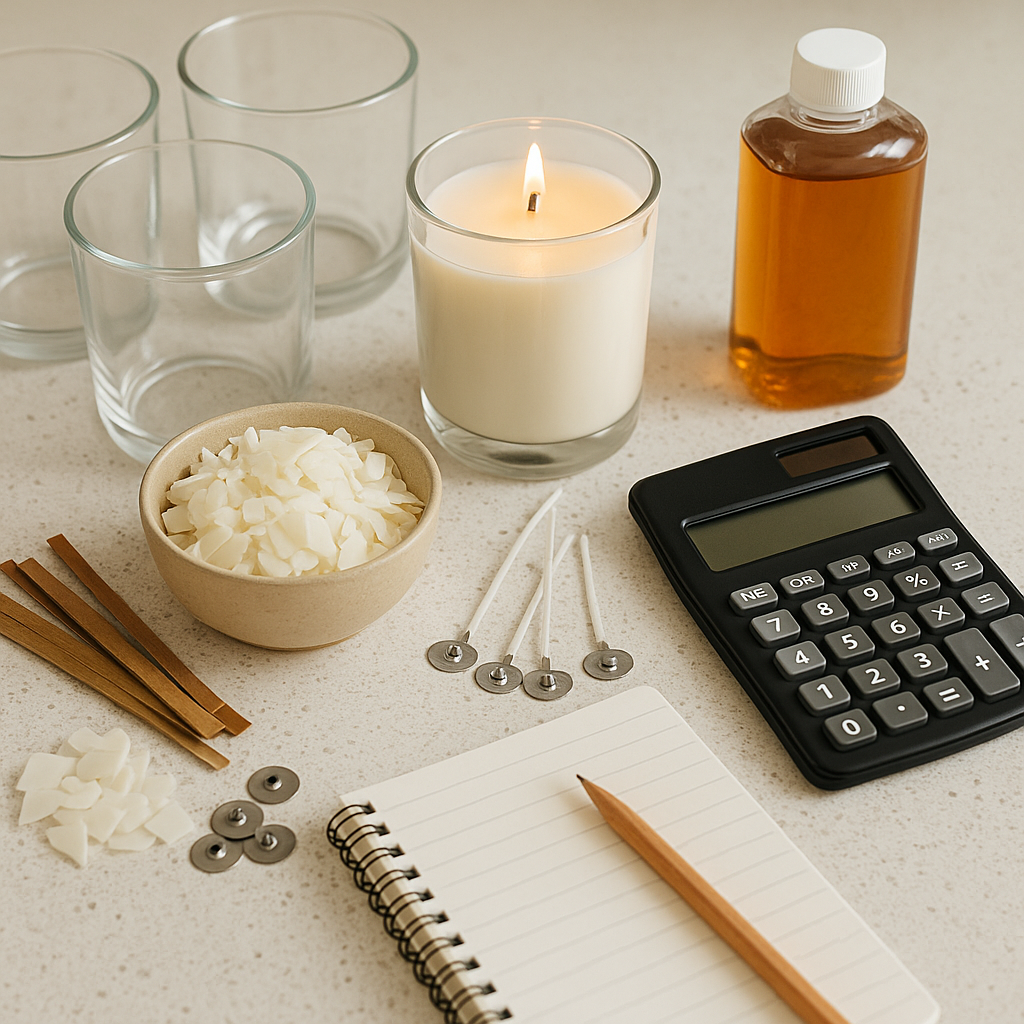
Article
All Calculators
Directions: Click the desired calculator link below to initiate download of the calculator excel file. Once you open the file, you may need to click enable editing at the top to be able to input numbers in the boxes for calculation.
How Many Candles Can I Make?
Trying to figure out how many candles you can make? This calculator will help you figure out how many candles you can make based on the amount of wax you have and how wax much each container will hold.
How Much Wax Do I Need?
If you want to know how much wax you will need to make a certain number of candles, download this calculator and quickly see how much wax you will need.
What Is My Fragrance Load?
If you are trying to achieve a certain fragrance load %, this calculator will help you figure out how to calculate a particular fragrance load %.
How Much Fragrance Oil Should I Use?
Not sure how much fragrance oil you need to use when making candles? Use this calculator to figure out exactly how much fragrance oil you need to use for your candle recipe.
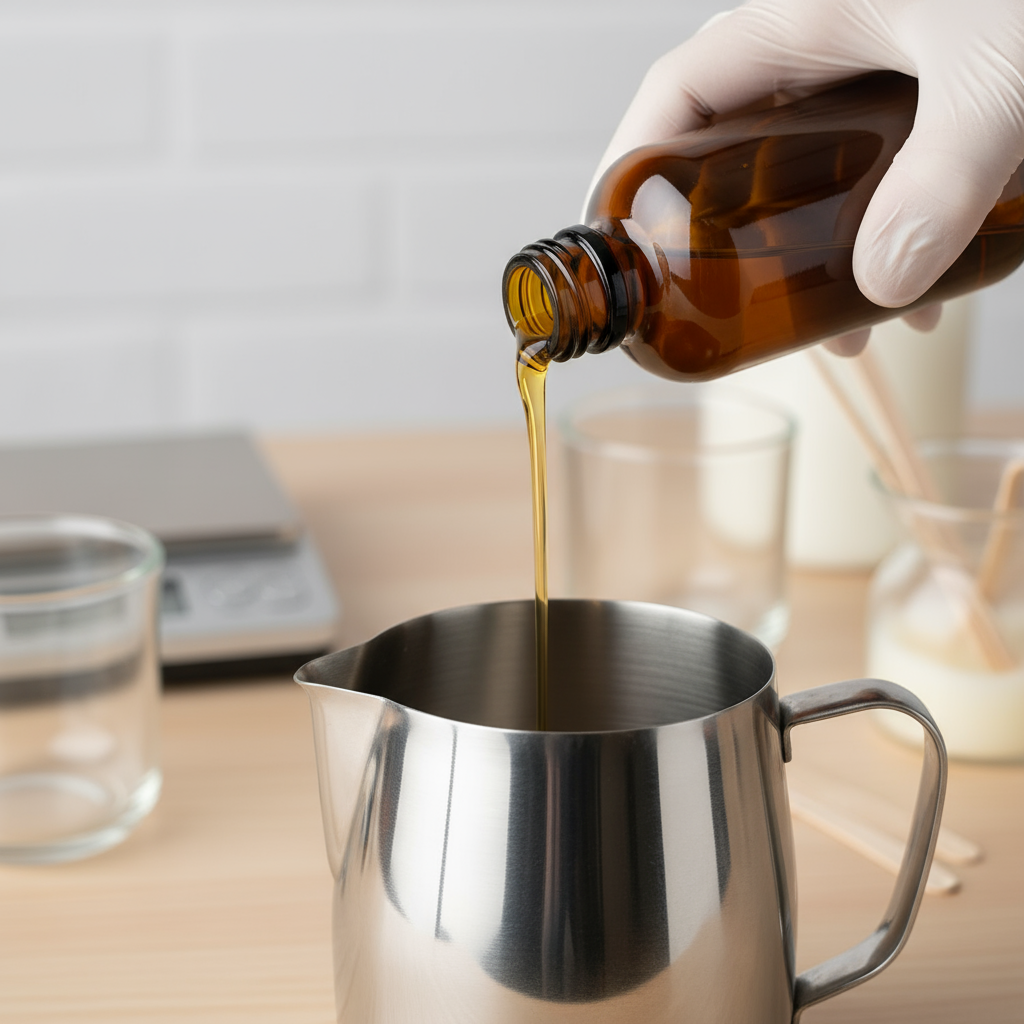
Article
How Much Fragrance Oil Do I Use?
We recommend using our fragrance oils at 1 oz. per pound, or about a 6% fragrance load. While some waxes can hold up to 2 oz. of fragrance per pound, we would not recommend using that much due to the high concentration of our fragrance oils. There are weaker fragrance oils on the market that are diluted with solvent and may take up to 2 oz. per pound to achieve a desired scent throw preference. However, the more additives, dye, and fragrance added to wax, the greater the chance of having issues with soot, smoke, and/or poor burning characteristics. Also, adding more fragrance oil does not necessarily mean it will improve the scent throw in candles. There is a point where adding more fragrance oil will add little or no additional scent throw.
For skin care product usage amounts, please see the IFRA information for each particular fragrance. Each fragrance has this information posted below the fragrance description on the fragrance product page.
You May Also Like
Top 10 Scents for Women

Article
When & How To Double Wick A Candle
There is no set rule for when a double wick should be used. However, a general guideline is that candles with a diameter of 4" or larger may need a double wick (or triple if preferred). The reason for using a double wick in larger diameter candles is to achieve a full burn pool, which can be challenging with only a single wick. There are large wicks designed for wider diameter candles. However, we have found that larger wicks are more prone to mushrooming, soot, and smoke. For this reason, a double wick may be a better alternative.
The decision on when to use a double wick is more of a personal choice. We have known candle makers to use double wicks in smaller diameter candles and others that prefer a single wick in a larger diameter candle. Testing is the only way to determine which wick choice (single or double wicking) is best for a particular application and will achieve optimal burning characteristics.
Double wicking a candle is really not difficult. The challenging part is finding the right wick size to use for a double wick. As a general rule of thumb on how to select the right wick size when using double wicks, find a wick that is designed for half of the candle diameter and start testing with two of that size. For example, if making a 5" diameter candle that will have double wicks, you may begin testing with a wick size that is designed for a 2.5" diameter candle. Be sure they are centered, spaced out about 1" apart from each other, and not too close to the side of the glass if using containers. Placing the wicks close to the sides can cause the glass to get too hot. Please remember that testing is the only way to determine the best wick size for a particular candle recipe.
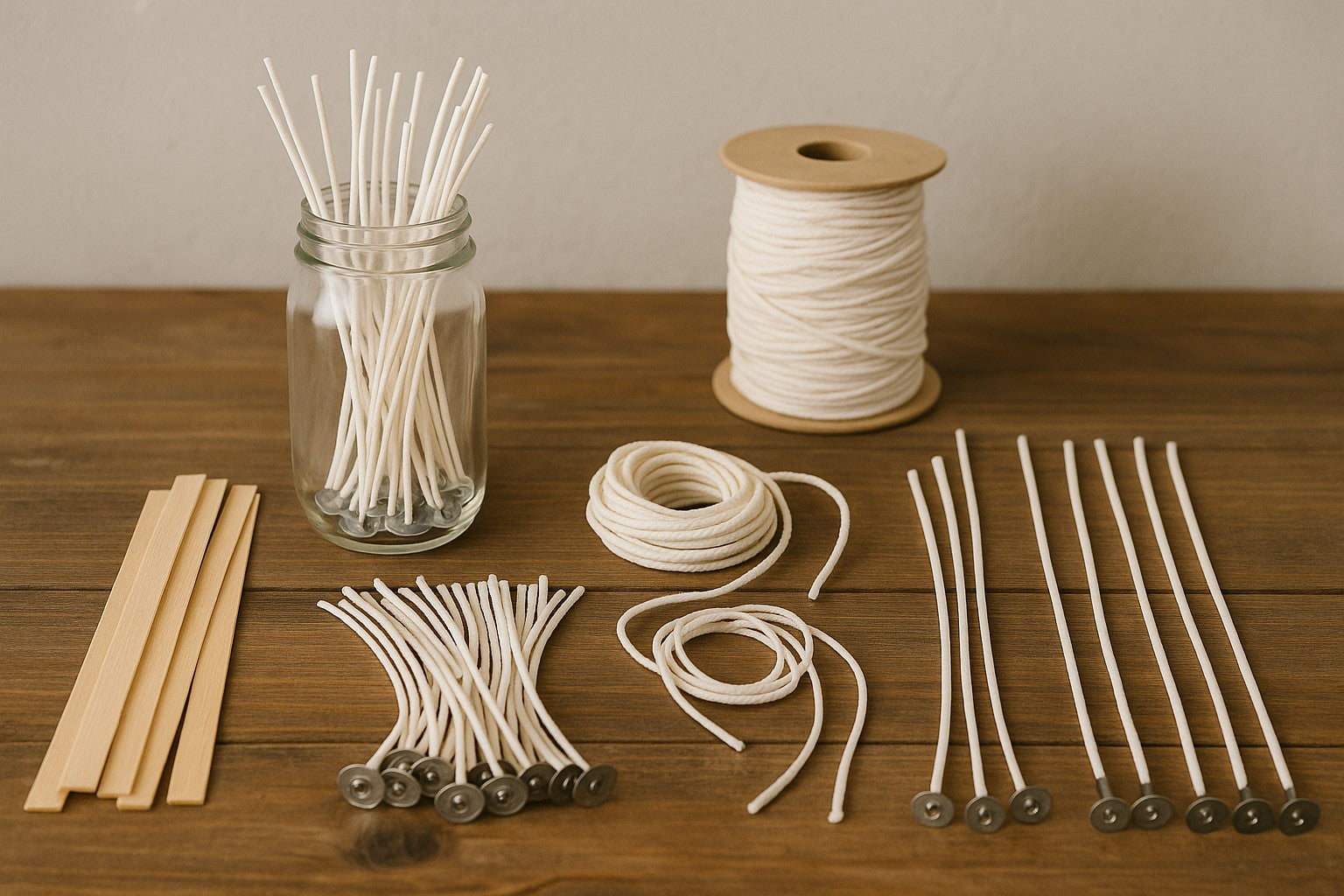
Article
What Candle Wick Size Do I Need?
Choosing a Candle Wick Size
Determining the best wick size to use is topic that generates a lot of questions. There are a variety of factors that can impact the size of wick to use and change how a candle burns. Since there are many variables that can affect a candle’s burning characteristics, there is no single answer on which wick size will work properly without performing testing for each candle recipe. Changing just one of the items listed below may mean modifying the wick size as well.
Some of the main things that can determine the best wick size for your recipe are:
Wax used (paraffin, vegetable/soy, etc.)
Type and amount of dye used
Amount of fragrance oil used
Amount and types of additives added
Candle diameter
Because of the many factors that can impact the burning characteristics of a finished candle, the only way to determine the best wick size for each particular candle is through testing. Testing can be one of the challenging parts of candle making. However, if you keep detailed notes, it can become easier as you become more familiar with how well certain recipes work. We offer a wick guide to help with suggested starting points. However, there is no substitute for testing to determine the optimal wick size for each particular candle recipe.
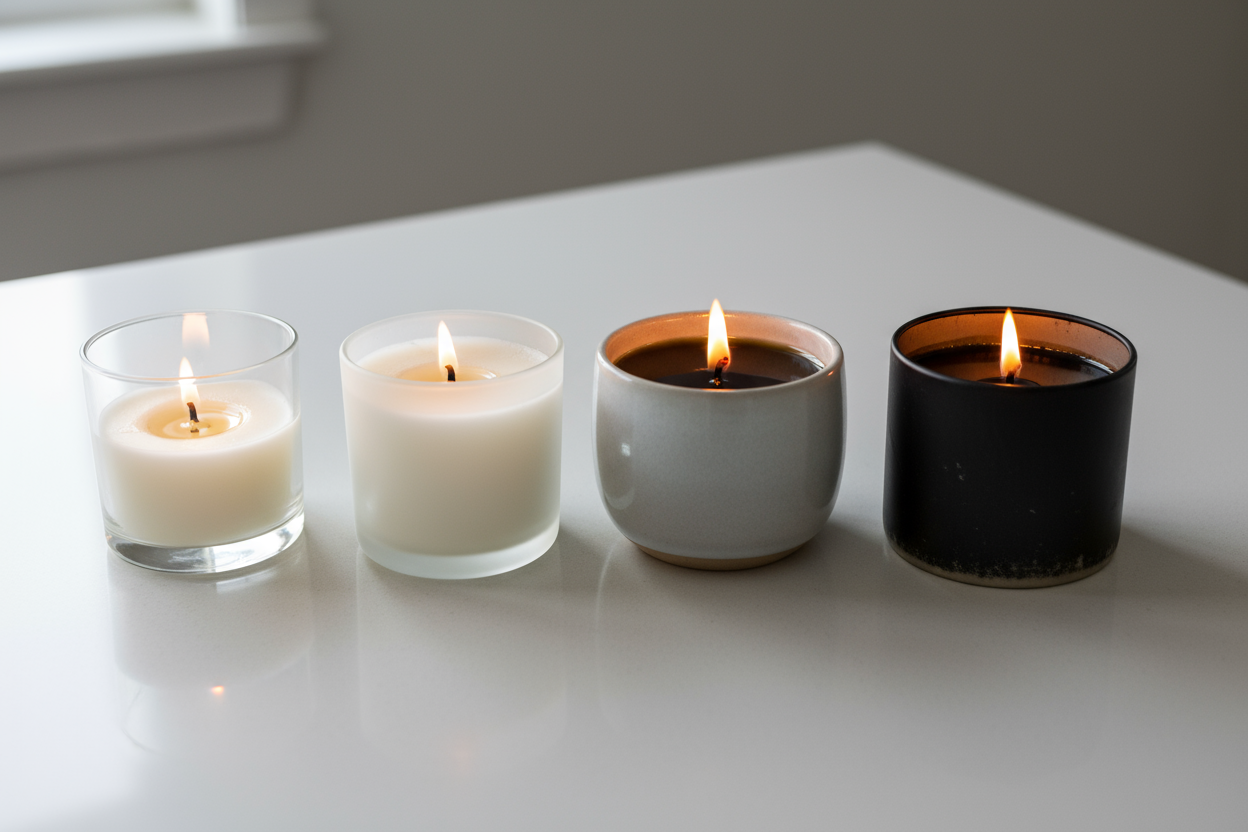
Article
How To Perform Candle Wick Testing
Candle Wick Testing Method
While each candle maker may have their own preferred way of testing, one method we recommend is by pouring 3 to 5 candles that are all the same except for wick size. You can do this by choosing the wick size you think you may need and then also choosing the next size(s) up and down, which should give you an idea of what wick size works best after testing. For example, if you think you may need an ECO-8 for a particular candle recipe, you may also want to test an ECO-6 and an ECO-10. Once they have cured, you can then burn them next to each other to see which wick size burns the best compared to the others.
You can also use this method on multiple types of wicks to determine what wick type works best for a particular candle recipe. For example, you may pour 3 to 5 candles each for ECO, HTP, and Premier wicks and then test burn them next to each other to see which wick type and size works best. You can also place the different wick types in different rooms of comparable size and ventilation and test to see if one particular wick type provides a better scent throw than the others.
When testing, we recommend doing at least 3 test burns before making a final decision on which wick size or type to use. Each test burn should be around 2 to 3 hours (possibly shorter or longer depending on the candle diameter) to allow time for a full melt pool to form. For container candles, it is not uncommon to have ‘hang-up,’ or wax remaining on the side of the container, after the first or second burn, which ‘catches up’ on the third burn and beyond. This is why it is important to do at least 3 test burns before making a final decision on which wick size to go with.
If you sell or will be selling container candles to others, we strongly recommend test burning candles all the way down before deciding on a wick size. A candle’s burning characteristics can change as the candle burns further down into the container (especially for odd shaped containers).
Tips for choosing the right wick size:
The candle should achieve a full melt pool that is ¼” to ½” deep within 1 hour for each inch of diameter. For example, a 2” diameter candle should achieve a full melt pool within 2 hours.
The flame should be approximately ½” to 2” in height, with smaller candles being closer to ½” and larger candles going to as high as 2”.
The flame should not be producing excess smoke, soot, or mushrooming. The flame should also not flicker or dance around, but should be a still, steady flame.
Lower melt point paraffin waxes (such as single-pour waxes), vegetable/soy waxes, and beeswax are more viscous in nature and generally require a larger wick size than standard paraffin wax.

Article
What Do Candle Wick Numbers Mean?
Understanding Candle Wick Numbers
This is one of the most common questions we receive. The wick numbers represent the size of the wick. Candles need the right wick size specific to their diameter to burn correctly. Smaller diameter candles require smaller wick sizes and larger diameter candles require larger wick sizes (unless you are using more than one wick).
As a general rule, the larger the wick number, the larger (thicker) the wick size. This is important when determining the right wick size to use for a specific candle diameter. Using too small of a wick will lead to 'tunneling' or will cause the flame to drown out. Using too large of a wick size will lead to excess smoking, soot, and/or mushrooming, as well as cut down on the candle burn time. Understanding the wick size number is essential to ensure you are using the right wick size that will lead to optimal burning characteristics.
Some wicks have 3 different numbers for the wick size. For example, one of our zinc wick sizes is 60-44-18. Below is a description of what the numbers represent:
The first number tells you the wick size. The size of the wick is determined by how many spools of yarn were used to make the wick. The higher the number, the larger the wick. As a general rule, the larger wick sizes will have a bigger melt pool and usually have higher wax consumption.
The second number indicates the speed at which the wick was sent through the braiding machine. The higher the number, the faster the speed and the tighter the braid. Wicks with a tighter braid have less fuel (wax) consumption.
The third number is a code for the temperature of the wax as the wick is fed through the gears of the braiding machine. This temperature varies according to the two previous numbers.
Note: Many pre-tabbed wicks may appear to be the same thickness even though they are different wick sizes. Smaller wick sizes tend to have a thicker wax coating which creates the illusion of having the same thickness of larger wicks sizes. However, these wicks will burn differently when used in a finished candle.